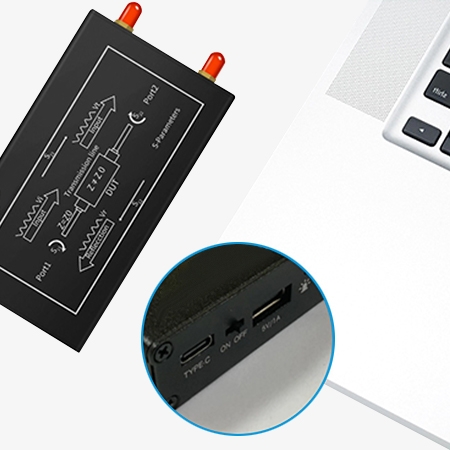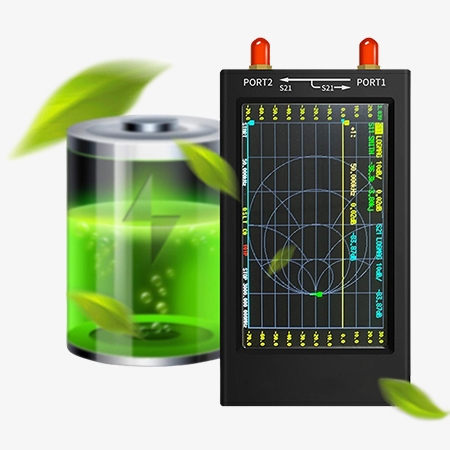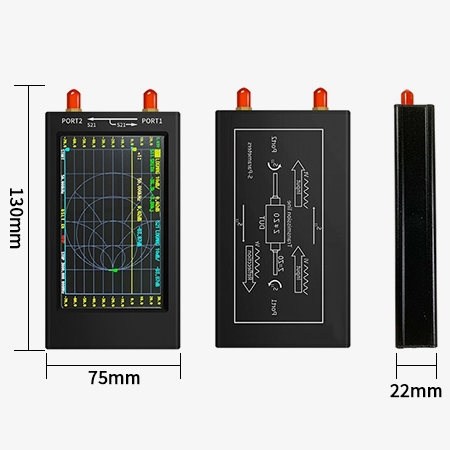The RF Network Analyzer combines high-precision measurements, portable operation, and extensive functionality, making it an ideal tool for RF device testing and field maintenance.

Wideband, Fast Scanning, and Touch-sensitive Operation
- The VNA RF covers a frequency range of 50kHz–3GHz, with an S21 dynamic range of 70dB from 50kHz–1.5GHz and an S11 dynamic range of 50dB in the same frequency range. It also offers excellent performance in high-frequency bands, enabling precise measurement of various RF device characteristics from low frequencies to 3GHz, meeting diverse testing needs.
- The vector analyzer network scans 101 points, with a scan time of just 1.5 seconds per scan. It can store five sets of calibration results, significantly improving test efficiency and streamlining R&D, quality inspection, and other tasks.
- The VNA network analyzer features a 4.3-inch 800×480 IPS LCD display with an ultra-wide viewing angle, making it easy on the eyes even after extended use. It also supports adjustable screen brightness. The full touchscreen and three side buttons provide flexible and convenient operation, and the user interface supports both Chinese and English. It also features an optimized UI.

Efficient Outdoor RF Tester
- Measuring only 130mm×75mm×22mm, it's compact and portable. Its durable all-aluminum alloy chassis effectively shields electromagnetic interference, ensuring measurement accuracy. Its built-in 5000mAh high-capacity lithium battery provides up to seven hours of battery life, making it suitable for mobile testing in outdoor and field environments.
- The VNA tester uses an SMA RF connector for easy connection to various devices under test. It supports firmware upgrades via a virtual USB drive using the included Type-C data cable, eliminating the need for a programmer and making it simple and convenient.
- The VNA network analyser comes with a high-quality SMA calibration kit and RG405 cable, enabling accurate testing right out of the box. It also features a USB power output port for powering other devices and a 2A high-current charging IC for faster charging and more efficient operation.
Applications
The first is component research and development and characteristic analysis to help engineers optimize device design; the second is electronic product production quality inspection to quickly detect whether the product meets performance standards; the third is communication and RF system debugging to ensure the normal operation of the system; the fourth is aerospace to accurately test its RF performance in a wide frequency range and complex environment to meet stringent technical indicators.

Electronics

Communications

Aviation

Components
| Model | SISCO-VNA-HGUYTIS |
| Frequency Range | 50kHz~3GHz |
| RF Output Power | -10dBm, 50kHz~140MHz |
| -9dBm, 140MHz~1GHz | |
| -12dBm, 1GHz~2GHz | |
| -14dBm, 2GHz~3GHz | |
| Frequency Deviation | <±0.5ppm |
| S21 Dynamic Range | 70dB, 50kHz~1.5GHz |
| 60dB, 1.5GHz~3GHz | |
| S11 Dynamic Range | 50dB, 50kHz~1.5GHz |
| 40dB, 1.5GHz~3GHz | |
| Number of Scanning Points | 101 |
| Number of Traces | 4 |
| Marking Points | 4 |
| Number of Calibration Results Stored | 5 groups |
| Scan Time | 1.5 seconds/time |
| Display | 4.3-inch IPS LCD, 800×480 resolution |
| Touch Screen | Resistive type |
| Battery | 3.7V 5000mAh |
| Charging/Data port | USB Type-C |
| Charging Voltage | 4.7V ~ 5.5V |
| Power Output | USB 5V/1A |
| RF Port | SMA |
| Dimensions | 130mm × 75mm × 22mm |
| Casing Material | Aluminum alloy |
| Operating Temperature | 0℃~45℃ |
| Package Wright | 300g |
Structure diagram

Q1: How to use a vector network tester?
A1: First, ensure the instrument has been preheated and stabilized. Clean the connectors between the test port and the DUT and check that the connecting cables are intact. Next, enter the instrument's operation interface, set parameters such as the test frequency range, number of points, and power according to your test requirements, and select the appropriate test mode. Calibrate according to specifications. After calibration, correctly connect the DUT to the test port, start the test, and wait for the instrument to acquire data.
Q2: What types of vector network testers are there?
A2: Vector network testers are primarily categorized as benchtop, portable, modular, and specialized types integrated into semiconductor test systems. There are also specialized vector network testers for high-frequency bands such as millimeter-wave and terahertz, as well as variants with enhanced features such as time-domain analysis and multi-port expansion to meet the needs of different industries and applications.
Q3: What factors affect the test accuracy of a vector network tester?
A3: The test accuracy of a vector network tester is affected by a variety of factors, including the instrument's own systematic errors, calibration quality, test environment, DUT characteristics, the quality of test accessories and connectors, and the operator's professionalism. These factors combine to determine the accuracy and reliability of the final measurement results.
Tips: How Should a Vector Network Analyzer be Maintained Daily?
Daily maintenance mainly includes: keeping the instrument's operating environment clean and dry, avoiding drastic changes in temperature and humidity; regularly cleaning the test ports and adapters to prevent dust and contamination that may affect measurement accuracy; gently connecting and disconnecting RF cables to avoid physical damage to the ports; regularly checking the instrument's fan and vents to ensure proper heat dissipation; and covering the instrument with a dust cover when not in use for extended periods of time and regularly powering it on to prevent moisture.
Thank you for buying industrial test and measurement equipment on SISCO.com, all products sold by SISCO and the partner cover a 12 months warranty, effective from the date of receiving the products.
What is covered?
SISCO is responsible for providing free spare parts, and free technical support to assist the customer to repair the defective products until the problem is solved.
What is not covered?
- Product purchased from anyone other than a SISCO store or a SISCO authorized reseller.
- Expendable parts.
- Routine cleaning or normal cosmetic and mechanical wear.
- Damage from misuse, abuse or neglect.
- Damage from use of parts other than SISCO approved.
- Damage from use outside the product’s usage or storage parameters.
- Damage from use of parts not sold by SISCO.
- Damage from modification or incorporation into other products.
- Damage from repair or replacement of warranted parts by a service provider other than a SISCO authorized service provider.
- Damage caused by the application environment not meeting the product usage requirements and the failure to perform preventive maintenance.

